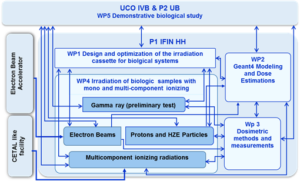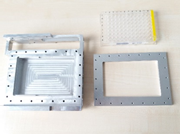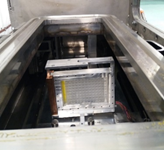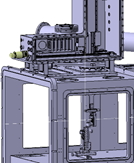Project 13 ELI
Development of the national technological platform for investigating the interaction of complex biological systems with space radiations in the context of ELI-NP
PROGRAM
PNCDI 3, Program 5 – Research in strategic domains, Subprogram 5.1 The research, development and innovation program for technologies in the field of ultra-power lasers – ELI-RO. Project type: R&D
Place of the project in the framework/context of the ELI-NP White Book
5.6.15 Materials research in high intensity radiation fields
TDR4 topic 2.6. Biological systems under irradiation
Project duration
01.09.2016 – 31.08.2019
Consortium
Coordinator
”Victor Babeș” National Institute of Pathology, Bucharest, ROMANIA (IVB)
Project director: Prof. Mihail Eugen HINESCU
Partner 1
“Horia Hulubei” National Institute for R&D in Physics and Nuclear Engineering, Măgurele, ROMANIA (IFIN-HH)
Project responsible: Dr. Cristian POSTOLACHE
Partner 2
University of Bucharest, Faculty of Biology, Bucharest, ROMANIA (UB)
Project responsible: Assoc. Prof. Marina Tamara NECHIFOR
Budget
1,070,700.00 Lei
Useful links
ELI-RO IFA http://www.ifa-mg.ro/eli/
ELI –NP http://www.eli-np.ro/
“Victor Babeș” National Institute of Pathology http://www.ivb.ro/v2/index.php/en
“Horia Hulubei” National Institute for R&D in Physics and Nuclear Engineering https://www.nipne.ro/
University of Bucharest, Faculty of Biology http://www.unibuc.ro/e/facultati/biologie/index.php
Project Summary
ELI-NP is a unique facility to generate multi-component, multi-energetic, space-like radiation in ground-based laboratory conditions, by interaction of two pulsed laser beams (1 PW, 25 fs) with two solid or gaseous targets in a large interaction chamber. Advanced studies on the interaction of complex biological system with multi-component ionizing radiation mimicking space radiation will foster knowledge and technology and help to develop an improved, evidence-based radioprotection system for deep space missions with human crew and possibly for the establishment of permanent human habitats on Mars.
The project has as main objective to setup the technologic platform for the investigation of the interaction of multi-component ionizing radiation with complex biological systems in the context of ELI-NP, and to demonstrate its functionality using proteins and cells exposed to mono-component ionizing radiation produced in existing national facilities. The project is organized in 5 work packages (WP), as follows: WP1 – Design and optimization of the irradiation cassette for biolgical systems, WP2 – Geant4 Dose Estimations, WP3 – Dosimetric methods and measurements; WP4 – Irradiation of biologic samples with mono- and multi-component ionizing radiation, WP5 – Demonstrative biologic study.
The project is in line with the domain 5.6.15 Materials research in high intensity radiation fields of the ELI-NP White Book. It is proposed by a Romanian multidisciplinary consortium made of two national research institutes, “Victor Babes” National Institute of Pathology (coordinator) and “Horia Hulubei” National Institute for R&D in Physics and Nuclear Engineering, in collaboration with the University of Bucharest, Faculty of Biology.
The main project outcomes are the following: a customized irradiation cassette providing adequate experimental conditions for biologic samples (cell monolayers, cell and organoid suspensions), a standardized set of simulations for dose estimation in cell culture settings, irradiation settings and modelling of conditions for multi-component radiation, relevant for the exposure of astronauts in deep space missions, molecular pathways related to oxidative stress, antioxidant response and redox signaling in immune cells exposed to proton, electron and/or HZE particle beams, a study-dedicated biobank to be used in the current study and in future investigations, publications and communication of results for promoting the project and ELI-NP, training of the next generation of scientists for ELI-NP.
We emphasize that, by taking advantage of the new “omics” technologies, the project will initiate a study for identifying critical molecular switches related to redox signaling for further developing targeted therapies to counteract the deleterious action of space radiation on the human organism.
The success of the project is sustained by the expertise of participating scientists and by their commitment to apply fundamental science for developing space-related and biomedical applications at ELI-NP.
Objectives
Main objective: setup of the biomedical platform for the investigation of the interaction of multi-component radiation with complex biological systems in the context of ELI-NP, and demonstration of its functionality by investigations on proteins and cells.
Specific technologic and scientific objectives
- To design and build the prototype of the irradiation cassette for biologic samples and the interface with the irradiation equipment;
- To simulate in silico the experimental conditions for the estimation of delivered doses in the irradiation setting of biologic samples with proton, electron and/or HZE beams;
- To design and test on-line dosimetric methods for controlled irradiation of biological samples;
- To perform irradiation experiments with proteins and cells exposed to proton, electron and/or HZE beams, using the existent national irradiation facilities;
- To evaluate at molecular level the biologic impact of ionizing radiation, related to oxidative stress and redox signalling.

Secondary objectives
- To create the core of a multidisciplinary team for solving complex issues raised by the interaction of biologic systems with multi-component ionizing radiation produced at ELI-NP;
- To attract and train students and young scientists in a highly innovative and multi-disciplinary research area;
- To increase the visibility of ELI-NP in the field of biomedicine, to establish collaborations for improving the current study and for opening new avenues for biomedical applications at ELI-NP.
Study flow char
Deliverables and outcome of the project
Deliverable | No |
Publications | 4 |
Communications | 10 |
Patent documentation submitted at the Romanian Office for Inventions and Trademarks (OSIM) | 1 |
Know-how and technology transfer within the consortium and towards ELI-NP | 2 |
Workshops | 4 |
Intermediary and final reports | 4 |
Milestones and expected results
Milestone | WP | Expected results |
Irradiation cassette for biologic studies at ELI-NP is built and tested | WP1 | Biological irradiation cassette providing adequate conditions for biologic samples (soluble and cellular samples), adequate for irradiation at ELI-NP and at the existing national irradiation facilities |
A set of dose estimations for proton, electron and heavy ions irradiation of biological material will be generated | WP2 | Standardized simulation set for dose estimations in cell culture settings, for the users of the technological platform interested in developing investigations on the interaction between biological samples and ionizing radiation in the context of ELI-NP applications |
Functional dosimetric system for biological samples exposed to proton, electron and/or heavy ions | WP3 | Validated dosimetric systems for characterizing the radiation fields inside the irradiation cassette for biologic samples, adequate for future irradiation at ELI-NP and at the existing Romanian irradiation facilities |
Controlled irradiation settings for proton, electron and HZE beams are ready for experimentation | WP4 | Fully characterized irradiation settings and experiments using biologic samples |
Biologic experiments with human and mouse immune cells and serum exposed to proton, electron or HZE beams are accomplished | WP5 | Study-dedicated biobank (IVB): post-irradiation and non-irradiated biological samples processed and stored for investigations in the current project and in future studies |
Dose- and time-dependent effects of proton, electron or HZE single and multicomponent beams on human serum components, oxidative stress in cells, morphology and functions of immune blood cells, gene expression profiles in immune blood cells, related to oxidative stress, antioxidant response and MAP kinase signaling | ||
Functional impact of irradiated serum or purified proteins on immune functions |
Summary of accomplishements
2016
Preliminary support research was performed, as follows:
1) design and fabrication of the first experimental model of the irradiation cassette;
2) evaluation and selection of dosimetry systems in the context of ELI-NP (E5);
3) first design of protocols for mono- and multi-component radiation fields;
4) evaluation by computation methods of dose distribution inside of irradiation cassette;
5) design of the first biological studies;
6) project promotion and dissemination of preliminary results by communications at scientific meetings (3), including by a project-dedicated workshop organized at IVB.
2017
First experiments using cells and proteins exposed to gamma irradiation were performed
1) improvement and testing of the first prototype of the irradiation cassette;
2) dose distribution evaluation inside the irradiation cassette by computation methods;
3) dosimetry measurements;
4) setup and testing of the experimental model for gamma radiation exposure of cell suspensions and protein solutions;
5) biobanking of irradiated biological samples and controls;
6) project promotion and dissemination of preliminary results by communications at scientific meetings (3) and publications (2).
2018
Experiments using cells exposed to X rays or electron beam were performed:
1) improvement and testing of the first prototype of the irradiation cassette;
2) dose distribution evaluation inside the irradiation cassette;
3) testing of the experimental model for exposure of cells to X rays and electron beams;
4) biobank with irradiated biological samples and experimental controls, as well as the revision of all the existing samples;
5) assessment of the gene expression profile of human monocytes exposed to electron beams;
6) evaluation of glucose-6 phosphate dehydrogenase activity in protein lysates of monocytes exposed to electron beams;
7) dissemination of results (9 communications, 2 publications, a workshop to be organized on 6.12.2018);
8) preparative phase of the experiments on monocytes irradiated with carbon ions, planned to be performed at GSI, Darmstadt, Germany in the first half of 2019, in the frame of the Programme AO-2017-IBER “INVESTIGATIONS INTO BIOLOGICAL EFFECTS OF RADIATION USING THE GSI ACCELERATOR FACILITY”;
9) purchase of the reagents needed in the 2018 phase;
10) Participation in the national Work Group for Nuclear Medicine with 3 project proposal drafts on future hadron therapy applications at ELI-NP.
Dissemination
2016-2017
- 3 papers accepted for publication in ISI journals (Romanian Reports of Physics, Romanian Journal of Physics and International Journal of Molecular Science);
- 3 communications at 2 scientific meetings (one international and one national);
- Workshop “Biomedicine in the context of ELI-NP”, organized in the frame of the Annual Scientific Meeting&10th National Pathology Symposium, “Victor Babes” National Institute of Pathology, 23-25.11.2017, Bucharest.
2018
- 2 publications
- 9 communications
- 1 workshop
List of publications
Romanian Reports in Physics (impact factor 1.467)
M.-R. Ioan, C. Postolache, V. Fugaru, S. Bercea, A. Celarel, C. Cenusa, Computational method for the determination of intense gamma-rays sources activity by using GEANT4 (http://www.rrp.infim.ro/IP/A322.pdf)
Romanian Journal of Physics (impact factor 1.758)
M-R. Ioan V. Fugaru, S. Bercea, A. Celarel, L. C. Tugulan, C. Cimpeanu, Co-60 specific gamma-ray constant (G) determinations for various biological materials involved in radiotherapy procedures, by using GEANT4 and NIST XCOM (http://www.nipne.ro/rjp/accpaps/036-Ioan_M_6140FE.pdf)
International Journal of Molecular Science (impact factor 3.226)
Burns JS, Gina Manda G. Metabolic pathways of Warburg effect in health and disease: perspectives of choice, chain or chance. Manuscript ID: ijms-238534.
List of talks
International Conference of Aerospace Sciences “AEROSPATIAL 2016” 26 – 27 October 2016, Bucharest, Romania
- Postolache, V. Fugaru, S. Bercea, A. Celarel, C. Cenusa, Characterization of gamma radiation fields emitted by 60-Co sources inside of multifunctional interaction chamber
- Manda, .I.V. Neagoe, C. Postolache, M. Bobeica. Redox biology in space missions – towards new molecular targets for radioprotection
21st National Conference with international participation “Progress in Cryogenics and Isotopes Separation”, 19-21 October 2016, Cãlimanesti-Cãciulata, Romania
- Postolache, V. Fugaru, New interaction chamber for evaluation of the outer space effects in materials
Physical Society 33rd International Physics Congress – TPS33, Bodrum Turkey, September 06 – 10, 2017
M-R Ioan, C Postolache, GEANT4 used for preliminary characterization of the new multipurpose Co-60 irradiator developed within ELI-RO 13/2016 Project
C Postolache, M-R Ioan, S Bercea, A Celarel, C Cenusa, Characterization of gamma radiation fields emitted by a new multipurpose 60-Co irradiator
20th Romanian International Conference on Chemistry and Chemical Engineering, Poiana Brasov, Romania, 6-9 September, 2017
Maria Mernea, Octavian Calborean, Livia Petrescu, Dan Florin Mihailescu, Marina Tamara Nechifor. Dose-dependent UVA effect on serum albumin addressed by THz spectroscopy.
Annual Scientific Meeting & 10th National Pathology Symposium, “Victor Babes” National Institute of Pathology, 23-25 November 2017, Workshop“Biomedicine in the context of ELI-NP”chaired by Dr. Mariana Bobeica & Dr. Gina Manda
Biomedical applications at ELI-NP, Mariana Bobeica, ELI-NP, Horia Hulubei National Institute of Physics and Nuclear Engineering, Magurele, Romania
Biological effects of ionising radiation on cellular metabolism characterized by non-invasive molecular imaging, Paul Vasos, ELI-NP, Horia Hulubei National Institute of Physics and Nuclear Engineering, Magurele, Romania
The ABEL project “Development of the national technological platform for investigating the interaction of complex biological systems with space radiations in the context of ELI-NP”, Gina Manda, “Victor Babes” National Institute of Pathology, Bucharest, Romania
New gamma irradiation facility for evaluation of space radiation effects on biological systems, Cristian Postolache, “Horia Hulubei” National Institute of Physics and Nuclear Engineering, Magurele, Romania
A glimpse into redox signaling triggered by gamma and X rays in monocytes, Gina Manda, “Victor Babes” National Institute of Pathology, Bucharest, Romania
Terahertz spectroscopy – a tool to probe protein dynamics, Maria Alexandra Mernea, Faculty of Biology, University of Bucharest, Bucharest, Romania
Nuclear Photonics 2018, 24-29.06.2018, Brasov, Romania
Romania New Biomedical Research Directions with High-Power Lasers at ELI-NP. M. Bobeica, D. Savu, V. Nastasa, T. Asavei, M. O. Cernaianu, P. Ghenuche, G. Manda, D. Stutman, and P. R. Vasos.
15th National Conference of Biophysics with international participation, International Satellite Meeting of Radiobiology, 10.09.2018, Magurele-Bucuresti, Romania
Gene Expression Profiles in Monocytic Cells Exposed To gamma and X Rays. Gina Manda, Maria Dobre, Ionela Victoria Neagoe, Cristian Postolache, Marina Nechifor and Mariana Bobeica.
International Conference of Aerospace Sciences AEROSPTIAL 2018, 25-26.10.2018, Bucuresti, Romania
Altered redox signalling in normal cells exposed to space-relevant radiation. Gina Manda, Maria Dobre, Ionela Victoria Neagoe, Cristian Postolache, Marina Nechifor, Mariana Bobeica, Theodor Asavei.
Pulse Irradiation Facility for Simulating Specific Conditions at ELI-NP E5 Experimental Area (Poster presentation). C. Postolache, V. Fugaru, M-R Ioan, A. Celarel, C. Cenusa.
Evaluation of Dosimetry Systems for Radiobiological Researches at ELI-NP (Postrer presentation). V. Fugaru, C. Postolache, A. Celarel, C. Cenusa, M-R Ioan, C S Tuta.
Nuclear Medicine Days, the 2nd meeting of the working group in Nuclear Medicine, 4.11.2018, Iasi, Romania
Nuclear Medicine in “Victor Babes” National Institute of Pathology. Gina Manda.
Annual Scientific Meeting of „Victor Babes” National Institute of Pathology and the 11th National Symposium of Pathology, 22-24.11.2018, Bucharest, Romania
High Dose-Rate Radiation and Endogenous Biomarkers – Perspectives for Early Imaging of Biological Effects. T. Asavei, M. Bobeica, V. Nastasa, M. O. Cernaianu, P. Ghenuche, D. Savu, D. Stutman, M. Radu, K. Tanaka, D. Doria, P. R. Vasos.
8-th International Advances in Applied Physics & Materials Science Congress and Exhibition, APMAS 2018, 24-30. 04.2018 Fetye Mulaga, Turkey
Determination of Punctual Dose and Surface Dose Distribution Using Alanine Dosimeter and Gafchromic Films (Poster presentation). C S Tuta, C. Postolache, A. Celarel, S. Bercea, C. Cenusa, V. Fugaru, M-R Ioan, ,
22nd Conference “New Cryogenic and Isotope Technologies for Energy and Environment” – EnergEn 2018, 24 – 26.11.2018, Băile Govora, Romania
Characterization of Gamma Radiation Fields Emitted by 60-Co Sources Inside of the Chambers for Simulation of Specific Outer Space Conditions (Oral presentation). C S Tuta, C. Postolache, A. Celarel, C. Cenusa, V. Fugaru, M-R Ioan,
Other deliverables
- Experimental model of cassette for the irradiation of biological samples at ELI-NP E5
Experimental area


- 3 project proposals submitted to the national Work Group for Nuclear Medicine, for future hadron therapy applications at ELI-NP (see attachment).
- Redox, inflammatory and angiogenic signalling networks underlining tumor and normal cells exposure to laser-generated radiation beams
- Harnessing anti-tumoral immune response through innovative irradiation
- In vivo evaluation of the blood disorder risk associated with the mutagenic effects of radiation-exposure on hematopoietic stem cells.
International collaboration
The IVB team is currently developing research in the field of redox biology which is one of the main research topics related to the interaction of ionizing radiation with biological systems: 1) Collaboration with the EU-ROS consortium – COST Action BM1203 (2012-2016); 2) Collaboration with Prof. Antonio Cuadrado from the Autonomous University of Madrid, Spain in the field of the transcription factor Nrf2 which is critically involved in the activation of the antioxidant response and may be a valuable drug target for modulating oxidative stress in pathological conditions, including exposure to ionizing radiation. Prof. Cuadrado is coordinating the project “Knowledge transfer in redox biology for developing advanced molecular tools in neurodegenerative diseases – focus on the signature of NRF2 transcription factor in diagnosis and therapy”, acronym REDBRAIN, project ID P_37_732, financed by European Funds for Regional Development through the Competitiveness Operational Program 2014-2020, that is currently implemented in IVB. Moreover, we are partners with Prof. Cuadrado in the M-Era.Net project NANOTHER (2016-2019).
The IFIN-HH team develops research activities in the field of the interaction of the ionizing radiations (photons, leptons and hadrons) with condensed matter. Radiation hardness assurance testing of materials for nuclear applications IFIN HH team develops research in cooperation with Politehnica University of Bucharest (materials for the 4th generation of nuclear power plant), Karlsruhe Institute of Technology Germany, National Institute of Research and Development for Cryogenic and Isotopic Technologies Rm Valcea Romania, National Institute for Laser, Plasma and Radiation Physics Magurele Romania, Nuclear Engineering Technology Center, Magurele Romania. Support programs: Core Program, The National Research-Development and Innovation Program II and III, EURATOM program, Romanian CANDU nuclear power plant program, Joint European Torus and International Thermonuclear Experimental Reactor programs. Evaluation of cosmic stressors effects in materials, electronic devices and biological systems This domain was developed after 2012 in cooperation with ELI NP E4 and E5 Experimental area team, the National Institute of Pathology „Victor Babes” (elaboration of TDR HPLS-TDR4/2015 Materials in extreme environments for Energy, accelerators and space applications; Simulation of cosmic rays effects on the cell suspensions), University of South Carolina-Department of Mechanical Engineering USA, University of Bucharest-Faculty of Physics, National Institute for Aerospace Research Elie Carafoli Bucharest, University of Craiova, Faculty of Electrical Engineering, Technical University of Civil Engineering Bucharest Institute of Solid Mechanics of the Romanian Academy (Determination of cumulative effects of radiation, temperature and vacuum on piezoelectric wafer active-PWAS and fiber optics-FOBS sensors). Support programs: Core Program, Space Technology and Advanced Research Program (STAR). Ionising radiation dosimetry Cooperation with Laboratoire National Henri Becquerel (LNHB) – CEA Saclay France, University of Bucharest-Faculty of Physics (Absorbed dose simulation, developing of new dosimetry systems; treatability of dosimetry measurements). Support programs: the national Core Program, IFA CEA Program.
